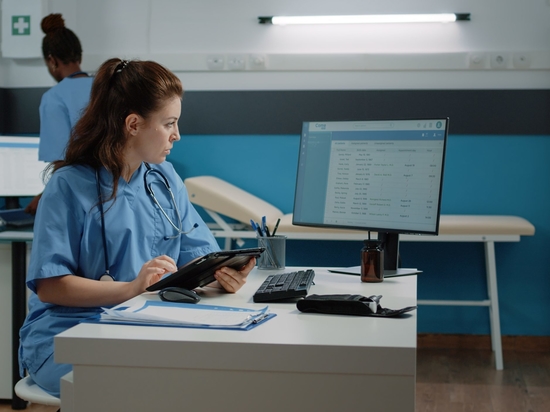
#Industry News
Medical-Grade vs. Regular Monitors: Differences Explained
Why the right monitor can save lives
Computers have become an essential part of healthcare, no matter which department you are in. In medical settings, it is important to have high-quality monitors designed specifically for medical purposes. These monitors must comply with certain requirements and certifications that are different from regular monitors that you use at home.
Selecting the right monitor is crucial when it comes to saving lives in the medical industry. That's why it is vital to use the best medical-grade monitors available.
Understanding Medical-Grade Monitors
A medical-grade monitor is purpose-built to operate effectively in healthcare settings, where reliability, hygiene, and precision are paramount. Unlike typical consumer-grade monitors, medical-grade monitors are engineered to deliver consistent performance in challenging conditions.
Medical-grade monitors find their utility in a wide range of healthcare applications. They are commonly used in diagnostic imaging, surgical procedures, record-keeping, telemedicine, and more. The significance of these monitors becomes evident in scenarios where high image quality and resolution are critical, such as identifying tumors or determining the best approach for treating fractures.
Critical Characteristics of Medical-Grade Monitors
Medical-grade monitors designed for medical use are made to meet the high standards of healthcare environments. These monitors provide clear and accurate images, are dependable, easy to clean, and meet strict safety requirements. They are essential tools in the healthcare industry, where accuracy and safety are very important.
High Image Quality and Resolution: Medical-grade monitors are renowned for their exceptional image quality and resolution. This is pivotal in healthcare, where accurate visualization can be a matter of life and death.
Reliability: Medical-grade monitors are engineered to operate continuously for extended periods, sometimes without being powered off for days. This reliability is vital in healthcare settings, ensuring the monitor performs consistently.
Hygiene and Durability: These monitors are designed with a focus on hygiene. They are both dustproof and water-resistant, typically rated at IP65. This feature is essential as medical monitors must withstand rigorous cleaning routines with heavy-duty disinfectants without sustaining damage.
Compliance with Medical Standards: A defining factor that sets medical-grade monitors apart is their compliance with medical standards. These monitors hold certifications such as UL/cUL 60601-1 and IEC 60601, ensuring their safety for use near patients and other medical equipment in similar environments. Without such certifications, a monitor cannot be considered genuinely medical grade.
Durability and Reliability: While durability and reliability are crucial for any monitor, they are even more critical for medical-grade monitors. These monitors boast superior build quality, undergo stringent testing, and often come with extended product warranties.
Benefits of Medical-Grade Monitors
When it comes to healthcare, the equipment used can really affect the quality of care given to patients. Using medical-grade monitors made for medical purposes can make a big difference in how well patients are taken care of. These monitors have a lot of advantages that help healthcare professionals do their jobs better and provide better care to patients.
1. Precision in Visual Representation
One of the fundamental advantages of employing medical-grade monitors is their ability to deliver precise and reliable visual representations. In healthcare, where even minor details matter, the confidence in a monitor to display bright, sharp, and crisp images can make all the difference. For instance, in radiology, where the interpretation of X-rays or biopsies is routine, this level of image quality is of the utmost importance and directly influences the accuracy of diagnoses.
2. Compliance With Medical Standards
One critical advantage that sets medical-grade monitors apart is their adherence to stringent medical certification standards. Foremost among these is the IEC 60601-1 standard, which is essential. This certification ensures that medical equipment, including monitors, does not emit harmful electrical discharge to patients or other connected devices.
In cases where a display is connected to essential medical equipment like heart monitors, ultrasound machines, or ventilators, the IEC 60601-1 certification becomes crucial. This certification guarantees that no electrical discharge from the monitor risks the patient's safety and ensures the integrity of the connected equipment.
3. Cost Efficiency
Cost efficiency is a critical consideration in healthcare, just as in any other industry.
Medical-grade monitors are cost-effective investments for healthcare organizations. These monitors undergo rigorous product evaluation and testing, resulting in lower maintenance costs and extended lifespans than similar devices. This translates to significant cost savings and reduced downtime in the long run.
Regular Monitors in Healthcare
Although regular computer monitors might work well for everyday use at home or in an office, they may not be the best option for healthcare settings. This is because they have some limitations that can affect their use in such environments. Let's take a closer look at why using consumer-grade monitors in healthcare may not be ideal.
Drawbacks of Consumer-Grade Monitors in the Healthcare Environment
Let's explore the drawbacks of using regular monitors in a healthcare context.
1. Lack of Regulatory Compliance
Standard monitors, not purpose-built for hospital or clinical settings, often lack essential certifications such as IEC 60601-1-. This can lead to significant regulatory issues and constraints on their usage within healthcare facilities. Staff may not always fully comprehend the ramifications of these certifications, potentially exposing the hospital to substantial liabilities due to accidental misuse.
2. Inadequate Visual Quality
Consumer-grade monitors don't have uniform color accuracy and may not offer screens that are easily legible in brightly lit environments. Within the context of a hospital, where precise visual detail is critical for accurate diagnoses, these limitations can hinder healthcare professionals' ability to assess conditions properly.
3. Unsuitability for Continuous Operation
Although consumer-grade monitors may seem more cost-effective initially, their use in medical settings can become expensive and time-consuming in the long run. These monitors are not designed for continuous operation or frequent cleaning, as necessary in healthcare environments.
4. Durability and Maintenance Challenges
In healthcare settings, maintaining strict sanitation standards is imperative. Monitors must undergo regular cleaning with heavy-duty disinfectants, often multiple times a day.
Consumer-grade monitors are ill-suited to withstand this rigorous cleaning, leading to their gradual degradation and eventual replacement.
So, while consumer-grade monitors may offer an initial cost advantage, their need for more clarity in meeting regulatory standards, subpar visual quality, unsuitability for continuous operation, and challenges in maintaining sanitary conditions make them impractical and costlier choices for healthcare environments. Investing in medical-grade monitors, designed with the unique healthcare demands in mind, is the more prudent and sustainable option in the long term.
When to Choose Medical-Grade Monitors
Choosing between a medical-grade and consumer-grade monitor depends on the specific needs and requirements of the environment in which the monitor will be used.
In essence, medical-grade monitors are essential in healthcare environments where image quality, patient safety, regulatory compliance, durability, hygiene, and long-term reliability are critical considerations. Medical-grade monitors are the best choice for:
Critical Healthcare Applications (such as diagnostic imaging, surgical procedures, or patient monitoring)
Patient Safety
Specialized Healthcare Environments (such as radiology or operating rooms)
Consumer-grade monitors can suffice in non-critical or administrative tasks within healthcare, including administrative workstations, non-patient-facing displays, telemedicine for routine consultations, educational purposes, and entertainment/distraction in patient rooms.
In conclusion, the choice between medical-grade and consumer-grade monitors is not merely a matter of preference; it's a decision that directly impacts patient care, regulatory compliance, and the overall efficiency of healthcare facilities.
Medical-grade monitors are:
The pinnacle of excellence in healthcare imaging and diagnostics.
Offering unparalleled image quality.
Stringent safety standards.
Lasting reliability.
At Cybernet, we know how important it is to have high-quality medical-grade monitors in today's healthcare industry. Our displays are designed specifically for healthcare settings and are made to meet and surpass the demands of such an environment.
Make the smart choice for your healthcare facility by choosing Cybernet's medical-grade monitors. Contact us today or explore our range of medical-grade monitors.






